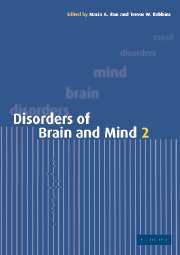Book contents
- Frontmatter
- Contents
- List of contributors
- Preface
- Part I Genes and behaviour
- Part II Brain development
- Part III New ways of imaging the brain
- Part VI Imaging the normal and abnormal mind
- Part V Consciousness and will
- Part IV Recent advances in dementia
- 12 The neurobiology of the tauopathies
- 13 Advances in early diagnosis and differentiation of the dementias
- Part VII Affective illness
- Part VIII Aggression
- Part IX Drug use and abuse
- Index
- Plate section
- References
12 - The neurobiology of the tauopathies
from Part IV - Recent advances in dementia
Published online by Cambridge University Press: 19 January 2010
- Frontmatter
- Contents
- List of contributors
- Preface
- Part I Genes and behaviour
- Part II Brain development
- Part III New ways of imaging the brain
- Part VI Imaging the normal and abnormal mind
- Part V Consciousness and will
- Part IV Recent advances in dementia
- 12 The neurobiology of the tauopathies
- 13 Advances in early diagnosis and differentiation of the dementias
- Part VII Affective illness
- Part VIII Aggression
- Part IX Drug use and abuse
- Index
- Plate section
- References
Summary
Introduction
Current concepts of neurodegenerative diseases began to develop over a century ago, when the German school of neuropathologists described the salient histological features of what we now know to be the most common of these diseases. In 1907, Alois Alzheimer described the neuritic plaques and neurofibrillary lesions in the disease that was subsequently named after him (Alzheimer 1907). In 1911, Alzheimer also described the presence of Pick bodies as the characteristic neuropathological lesion of Pick's disease, a form of frontotemporal dementia (Alzheimer 1911). In 1912, Friederich Lewy described the inclusions characteristic of Parkinson's disease, the so-called ‘Lewy bodies’ (Lewy 1912). In the 1960s, electron microscopy was used to show that the above inclusions are made of abnormal filaments (Kidd 1963; Duffy and Tennyson 1965; Rewcastle and Ball 1968). At the time, the identification of these lesions was instrumental in establishing the various diseases as discrete entities. However, this work did not indicate a role for the lesions in the aetiology and pathogenesis of neurodegeneration. Over the past 20 years, a direct correspondence between the formation of the neuropathological lesions and the degenerative process has emerged. Besides the above diseases, this is also true of the prion diseases, of Huntington's disease and the other glutamine repeat diseases, as well as of several other, rarer conditions.
Progress was made possible by the merging of two independent lines of research. On the one hand, the biochemical study of the neuropathological lesions led to the identification of their main molecular components.
- Type
- Chapter
- Information
- Disorders of Brain and Mind , pp. 245 - 261Publisher: Cambridge University PressPrint publication year: 2003



